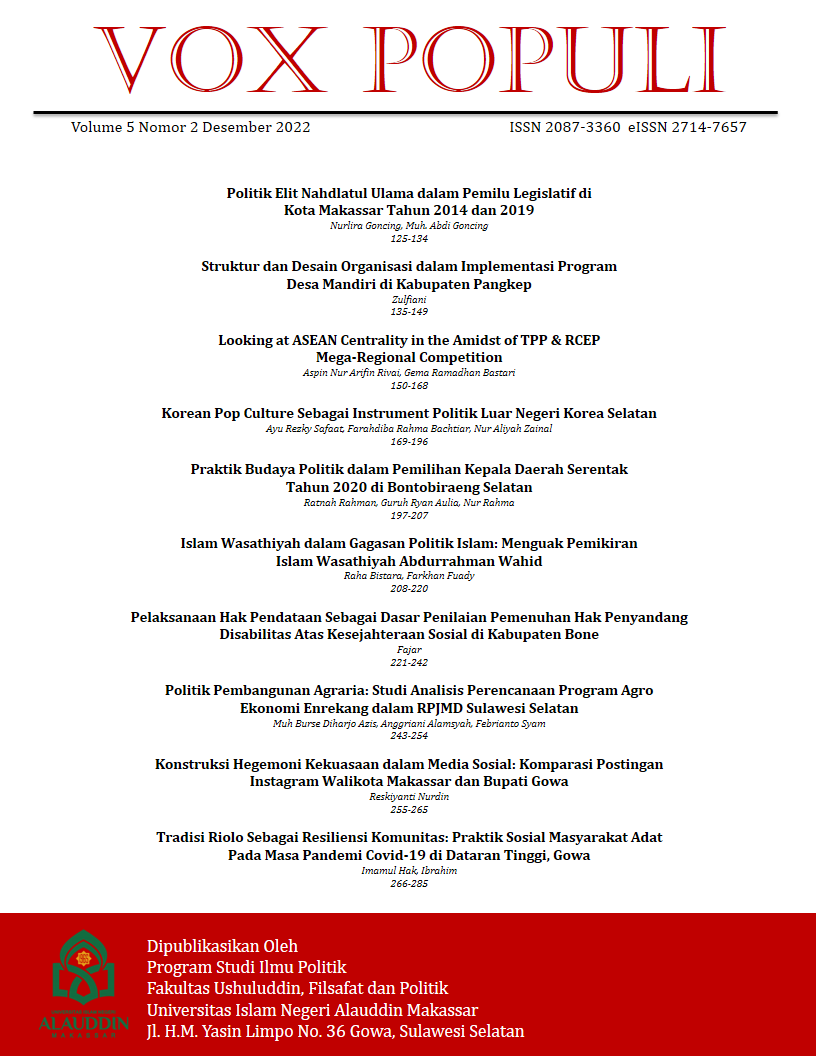Looking at ASEAN Centrality in the Amidst of TPP & RCEP Mega-Regional Competition
Abstrak
Tulisan ini bertujuan untuk memahami kembali progresifitas regionalisme ekonomi yang terjadi di kawasan Asia Tenggara. Berbeda dengan kajian-kajian sebelumnya, tulisan ini memaparkan kompleksitas kawasan Asia Pasifik sangat berpengaruh bagi konfigurasi liberalisme ekonomi di ASEAN. Persaingan mega-regional antara TPP dan RCEP menjadi ujian bagi sentralitas ASEAN yang disebabkan oleh Vietnam, Singapura, Malaysia, dan Brunei memilih bergabung dikeduanya. Padahal, RCEP sebagai agenda sentralitas ASEAN bersama negara mitra FTA. Paper ini memperhatikan dua bentuk kondisi yaitu: (1) memahami transformasi kemitraan mega-regional di Asia Pasifik, (2) memahami sikap empat negara tersebut yang memilih bergabung di dua model mega-regional. Teori yang digunakan ialah teori perdagangan baru yang dituliskan oleh Vinod K. Aggarwal dan Lee. Temuannya yaitu adanya pembaharuan persepsi, kepentingan dan reformasi institusi domestik mengiringi terciptanya RCEP dan TPP. Sementra itu, sikap Vietnam, Malaysia, Singapura, dan Brunei memilih bergabung dikeduanya sebagai pertimbangan keuntungan ekonomi, pertimbangan ekonomi-politik, motivasi perbaikan struktur domestik, dan pertimbangan keamanan. Keempat pertimbangan ini cenderung sama dihampir semua negara, khususnya memanfaatkan liberalisasi ekonomi yang lebih luas.
Referensi
Aggarwal, V. K., & Lee, S. (2011). The Domestic Political Economy of Preferential Trade Agreements in the Asia-Pacific. In V. K. Aggarwal, & S. Lee, Trade Policy in the Asia-Pacific: The Role of Ideas, Interests, and Domestic Institutions (pp. 1-25). New York: Springer.
Aggarwal, V. K., & Lee, S. (2011). The domestic political economy of preferential free trade agreements in. In V. K. Aggawrwal, & S. Lee, Trade Policy in the Asia-Pacific: The Role of Ideas, Interests and Domestic Institutions (pp. 1-25). London: Springer.
ASEAN . (2016). ASEAN Economic Com-munity: Chartbook 2016. Jakarta: ASEAN Secretariat.
ASEAN. (2016). ASEAN Economic Comm-unity Chartbook 2016. Jakarta: ASEAN Secretariat.
Capling, A. (2008). Australia's Trade Poli-cy Dilemmas. Australian Journal of International Affairs, Vol. 62 (2), 229-244.
Capling, A., & Ravenhill, J. (2011). Multilateralising Regionalism: What Role for the Trans-Pacific Partnership Agreement?. The Pacific Review, Vol. 24 (5), 553-575.
Charlermpalanupap, T. (2014). Understan-ding the ASEAN Centrality. ASEAN Insights, Vol. 4.
Dent, C. (2010). Free Trade Agreements in the Asia-Pacific a Decade on: Evaluating the Past, Looking to the Future. International Relations of the Asia-Pacific, Vol. 10 (2), 201-245.
Desker, B. (2004). In Defence of FTAs: From Purity to Pragmatism in East Asia. The Pacific Review, Vol. 17 (1), 3-26.
Higgot, R. (2004). US Foreign Policy and the Securitization of Economic Globalization. International Politi-cs, Vol. 41 (2), 147-175.
MacDonald, S. B., & Lemco, J. (2011). Asia's Rise in the 21st Century. California: Praeger.
NEAT China. (2014). Accelerating the RCEP Process Through Stregthening the APT Cooperation. Beijing: NEAT Working Group.
Petri, P. A., & Plummer, M. G. (2014). ASEAN Centrality and the ASEAN-US Economic Relationship. Honolulu: East-West Center.
Ravenhill, J. (2004). Trade politics in East Asia . In B. Hocking, & StevenMcGuire, Trade Politics (2nd Edition) (pp. 51-62). London: Routledge.
Ravenhill, J. (2008). The Move to Preferential Trade on the Western Pacific Rim: Some Initial Conclusions. Australian Journal of International Affairs, Vol. 62 (2), 129-150.
Soesastro, H. (1995). The Asia Pacific Region on the Threshold of 21st Century: Trends and Goals. The Indonesian Quarterly, Vol. 23 (4), 313-322.
Thangavelu, S. M., & Toh, M.-H. (2005). Bilateral ‘WTO-Plus’ Free Trade Agreements: The WTO Trade Policy Review of Singapore 2004. World Economy, Vol. 28 (9) , 1211-1228.
Zainal, M., & Rosli, F. (2013). Infrastru-cture Development In ASEAN. In S. B. Das (Ed.), ASEAN Economic Community Scorecard (pp. 136-162). Singapore: ISEAS.
Website
ADB. (2017, May 15). Asian Regional Integration Centre FTA Database. Retrieved from http://aric.adb. org/FTAbyCountryAll.php.
Bhagwati, J. N. (2017, May 21). America's Threat to Trans-Pacific Trade. Retrieved from https://www.pro ject-syndicate.org /commentary /america-s-threat-to-trans-pacific-trade.
Kenechi, K. (2017, May 25). Determining Priority Among EPAs: Which trading partner has the greatest economic impact?. Retrieved from RIETI: http://www.rieti.go.jp/en/ columns/a01_0318.html.
Kenechi, K. (2017, May 25). Determining Priority Among EPAs: Which trading partner has the greatest economic impact?. Retrieved from http://www.rieti.go.jp/en/columns/a01_0318.html.
RCEP. (2017, May 16). Guiding Principles and Objectives for Negotiating the Regional Comprehensive Econo-mic Partnership. Retrieved from http://www.asean.org/images /2012/documents/Guiding%20Principles%20and%20Objectives%20for%20Negotiating%20the%20Regional%20Comprehensive%20Economic%20Partnership.pdf.
Statista. (2018, May 12). ASEAN Countries: Gross Domestic Product (GDP) Per Capita in Current Prices from 2008 to 2018 (In U.S. Dollars). Retrieved from https://www.statista.com/statistics/804307/gross-domestic-product-gdp-per-capita-in-the-asean-countries/.
TPP. (2017, May 16). Enhancing Trade and Investment, Supporting Jobs, Economic Growth and Develop-ment: Outlines of The Trans-Pacific Partnership Agreement. Retrieved from https://www.dfat.gov.au/fta/ tpp/111112-tpp-broad-outlines.html.
World Trade Organization. (2017, May 16). Regional Trade Agreements Database. Retrieved from http://www.wto.org/english/tratop_e/region_e/region_e.htm .











